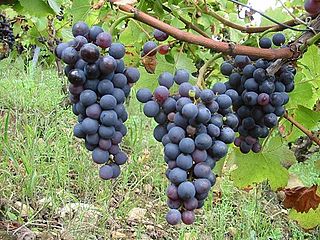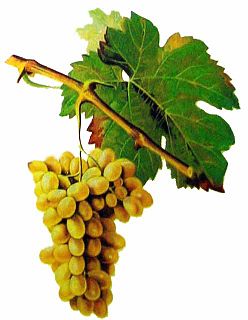Related Research Articles

Syrah, also known as Shiraz, is a dark-skinned grape variety grown throughout the world and used primarily to produce red wine. In 1999, Syrah was found to be the offspring of two obscure grapes from southeastern France, Dureza and Mondeuse Blanche. Syrah should not be confused with Petite Sirah, a cross of Syrah with Peloursin dating from 1880.

Folle blanche, also known as Picpoule, Gros Plant, and Enrageat blanc, is a wine grape variety from southwest France. It was the traditional grape variety in Cognac and Armagnac production until the 20th century. Folle blanche is an offspring of Gouais blanc, with the other parent so far unidentified.

Durif is a variety of red wine grape primarily grown in Australia, California, France, and Israel. Since the end of the 20th century, wineries located in Washington's Yakima River Valley, Maryland, Arizona, Texas, West Virginia, Chile, Mexico's Baja California Peninsula, and Ontario's Niagara Peninsula have also produced wines from Durif grapes. It is the main grape known in the U.S. and Israel as Petite Sirah, with over 90% of the California plantings labeled "Petite Sirah" being Durif grapes; the U.S. Bureau of Alcohol, Tobacco, Firearms and Explosives (ATF) recognizes "Durif" and "Petite Sirah" as synonyms for the same grape. It produces tannic wines with a spicy, plummy flavour. The grape originated as a cross of Syrah pollen germinating a Peloursin plant. On some occasions, Peloursin and Syrah vines may be called Petite Sirah, usually because the varieties are extremely difficult to distinguish in old age.

Bugey wine is produced in the Bugey region in the Ain département of France, under the two VDQS designations Bugey and Roussette du Bugey. On May 28, 2009, INAO gave its final approval for the elevation of Bugey and Roussette du Bugey to Appellation d'origine contrôlée (AOC) status.

Poulsard is a red French wine grape variety from the Jura wine region. The name Ploussard is used mainly around the town of Pupillin but can appear on wine labels throughout Jura as an authorized synonyms. While technically a dark-skinned noir grape, the skins of Poulsard are very thin with low amounts of color -phenols and produces very pale colored red wines, even with extended maceration and can be used to produce white wines. Because of this, Poulsard is often blended with other red-skin varieties or used to produce lightly colored rosé wines. Additionally the grape is used to make blanc de noir white wines and sparkling cremants.

Clairette blanche is a white wine grape variety most widely grown in the wine regions of Provence, Rhône and Languedoc in France. At the end of the 1990s, there were 3,000 hectares of Clairette blanche grown in France, although volumes are decreasing.

Mondeuse noire is a red French wine grape variety that is grown primarily in the Savoy region of eastern France. The grape can also be found in Argentina, Australia, California, Switzerland and Sicily. Plantings of Mondeuse noire was hit hard during the phylloxera epidemic of the mid to late 19th century which nearly wiped out the vine from eastern France. While the grape recovered slightly in the 20th century, French plantations of Mondeuse noire fell sharply in the 1970s, with just over 200 hectares left in France in 2000. In the early 21st century, it seems the variety has increased somewhat in popularity, as it can give good wines if the planting site is chosen carefully.

Piquepoul, Picpoul, or Picapoll is a variety of wine grape grown primarily in the Rhone Valley and Languedoc regions of France as well as Catalonia, Spain. It exists both in dark-skinned and light-skinned versions, as well as a very little grown Piquepoul gris. Piquepoul blanc is the most common of the Piquepouls, with 1,000 hectares cultivated in France in 2000, and an increasing trend.

Muscardin is a dark-skinned grape variety primarily found in the southern part of the Rhône region. It is primarily noted for being one of the thirteen grape varieties permitted in the Châteauneuf-du-Pape appellation. It is a very rare variety, and in 2004 only 0.4% of the appellation's vineyards were planted with Muscardin.

Picardan or Picardan blanc is a white wine grape which is one of 13 permitted blending grapes within the Châteauneuf-du-Pape AOC in Rhône wine region in France, although very little planted. The Vitis International Variety Catalogue previously listed Oeillade blanche as the primary name of the variety, but now identifies Araignan as the primary name. However, since the variety is practically unknown for any other use than the Châteauneuf-du-Pape blend, it most commonly goes under the name used for it in that appellation.
Mondeuse blanche is a variety of white grape almost exclusively found in and around the Savoy (Savoie) wine region in France. With just 5 hectares of plantations in 1999, it leads a dwindling existence and is used primarily in the VDQS wine Bugey and the AOC Vin de Savoie.

Dureza is a dark-skinned French wine grape variety from the Ardèche department of south central France in the Rhône-Alpes region. The grape is most widely known for being the father vine of Syrah—a discovery that confirmed that the Syrah vine was native to France and not introduced to the country from Persia, Sicily, Egypt or elsewhere, as had been speculated.

Jacquère is a variety of white grape found primarily in the Savoy wine region of France. It is a high-yielding vine variety which is used to produce lightly scented, refreshing and gently aromatic dry white wine, such as Vin de Savoie. Jacquère is the grape used in Apremont wines and is the usual wine paired with cheese fondue. It is also found in Bugey wines.
Joubertin is a red French wine grape variety that was historically grown in the Savoie wine region of southeast France. The grape was once prized for its productivity and high yields but its plantings have declined as the grape has fallen out of favor and it is now on the verge of extinction.
Jurançon is the name attributed to a red and white French wine grape variety that is grown predominantly in Southwest France. According to wine expert Jancis Robinson, both colors produce wines of average to low quality.

Verdesse is a white French wine grape variety grown primarily in the Bugey AOC of eastern France. It is also permitted under the Vin de Savoie AOC for wines produced in the Isère department up to a maximum allowance of 10%. Ampelographers believe that the variety is likely very old and originated along the Drac and Grésivaudan valleys in Isère.

Servanin is a red French wine grape variety grown predominantly in the Isère department in eastern France. While the variety has a long history in the region, plantings have been steadily declining since the early 20th century with the vine now close to extinction.

Persan is a red French wine grape variety that is grown primarily in the Savoie region. While the name hints at a Persian origins for the grape, it is most likely native to the Rhône-Alpes region with the name "Persan" being a corruption of the synonym "Princens" which is also the name of a small hamlet by Saint-Jean-de-Maurienne in Savoie which has been noted since the 17th century for the quality of its vineyards.
Œillade noire is a red French wine grape variety that has been historically grown in the Languedoc and Provence wine region but it is now close to extinction. The grape is often confused for the Rhone wine grape Cinsault which is known under the synonym œillade noire when it is sold as a table grape. It was also once thought to be a color mutation of Picardan which is known as œillade blanche and share several similar synonyms to œillade noire. However the grape has no known relation to both Cinsault and Picardan.
Bia blanc is a white French wine grape variety that is no longer commercially cultivated for wine production with only a few plantings existing worldwide in viticultural archives and experimental vineyards. The exact origins of Bia blanc are not yet known though ampelographers have noted that the grapevine shares some morphological similarities to the red Isère grape Peloursin, one of the parent varieties to Petite Sirah (Durif).
References
- ↑ J. Robinson Jancis Robinson's Wine Course Third Edition pg 113 Abbeville Press 2003 ISBN 0-7892-0883-0
- 1 2 Molette Archived 2012-05-13 at the Wayback Machine , Vitis International Variety Catalogue, accessed 2010-12-03